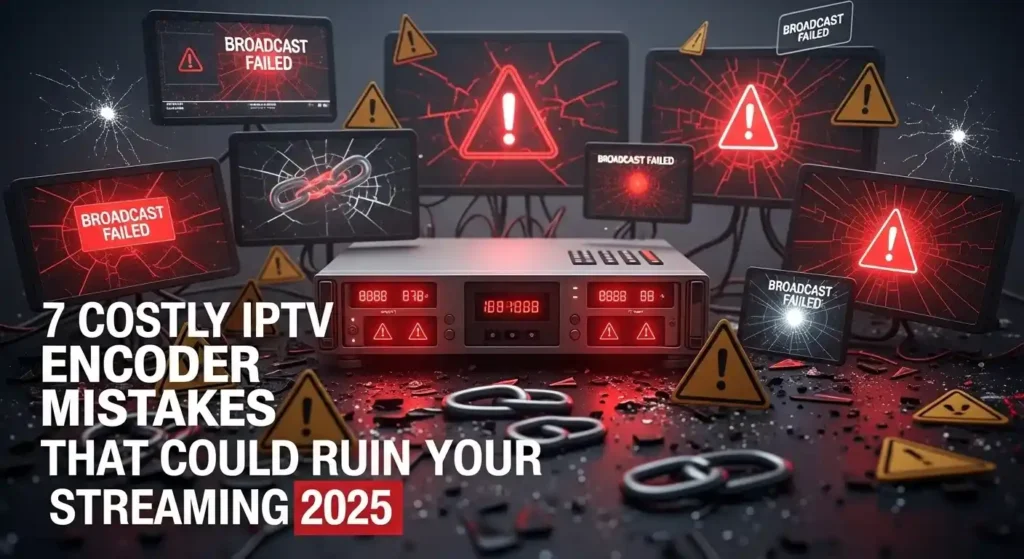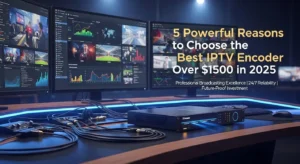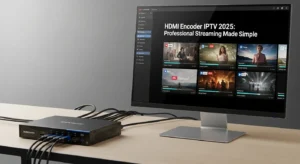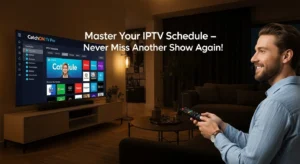An IPTV encoder can make or break your streaming quality, yet many broadcasters and content creators unknowingly sabotage their own success through preventable operational mistakes. While choosing the right hardware matters, the real streaming disasters happen when professionals overlook critical setup, maintenance, and planning decisions that can cost thousands in lost viewers and revenue.
In 2025’s competitive streaming landscape, viewers expect flawless performance across multiple devices and network conditions. A single encoder failure during peak viewing hours can destroy months of audience-building efforts and damage your brand’s reputation permanently.
This guide reveals the seven most damaging IPTV encoder mistakes that experienced streaming professionals make—and the proven solutions to avoid them. Whether you’re an IPTV reseller, broadcaster, or content creator, these insights will help you build a bulletproof streaming infrastructure that scales with your success.
Table of Contents
Mistake 1: Not Testing Your IPTV Encoder in Real-World Conditions
The biggest streaming encoder issues stem from relying solely on lab testing or manufacturer specifications. Your streaming encoder may perform perfectly in controlled conditions but fail spectacularly when facing real-world challenges like network congestion, varying input sources, and simultaneous viewer demands.
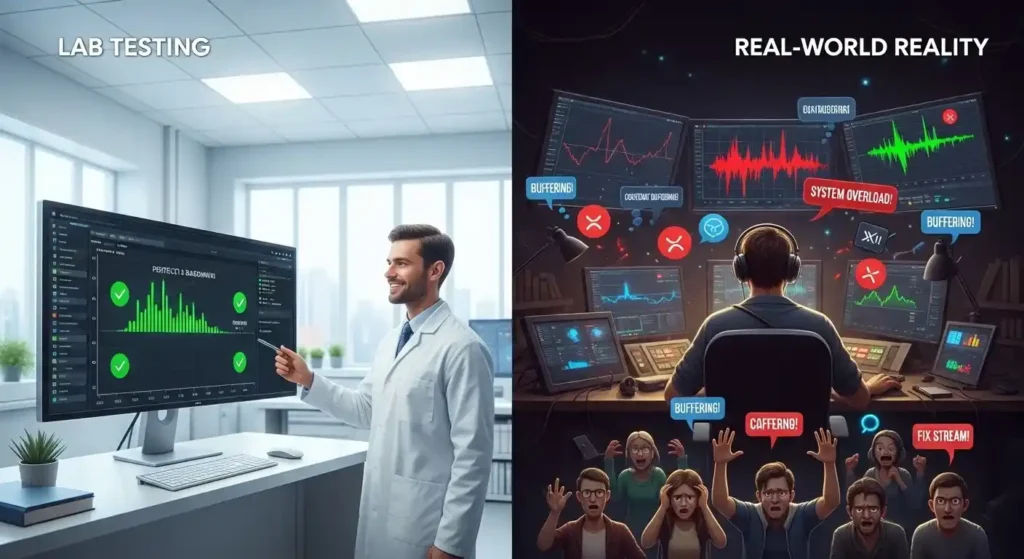
Why This Mistake Happens
Most professionals test their IPTV encoder setup using ideal conditions: stable internet, clean power, consistent input signals, and single-stream scenarios. However, live streaming environments involve unpredictable variables that can expose hidden vulnerabilities in your encoding configuration.
The Real-World Impact
When untested encoders go live, common failures include:
- Sudden quality drops during peak traffic
- Audio sync issues with certain input formats
- Encoder crashes under sustained high bitrate loads
- Incompatibility with specific CDN configurations
- Thermal throttling during extended broadcasts
How to Fix: Real-World Simulation Testing
Implement these testing protocols before going live:
Network Stress Testing
- Simulate varying bandwidth conditions (50% to 150% of expected capacity)
- Test encoder performance with packet loss between 0.1% and 2%
- Monitor encoding stability during network jitter scenarios
- Verify failover behavior when primary internet connection drops
Load Testing Checklist
- Run continuous 24-hour encoding tests with your target bitrate settings
- Test multiple simultaneous stream outputs (if applicable)
- Monitor CPU and memory usage under sustained loads
- Verify encoding quality consistency over extended periods
Input Source Validation
- Test all planned input sources (cameras, satellite feeds, file sources)
- Verify proper handling of resolution changes and frame rate switches
- Test encoder response to input signal interruptions
- Validate audio encoding with different source formats
Action Step: Create a testing environment that mirrors your production setup, including network conditions, input sources, and expected viewer loads. Document all test results and establish performance baselines.
Mistake 2: Skipping Firmware and Security Updates for Your IPTV Encoder
Security vulnerabilities and performance bugs in encoder firmware create serious risks for professional streaming operations. Outdated firmware leaves your IPTV encoder exposed to cyber attacks, stability issues, and compatibility problems with modern streaming protocols.
The Security and Performance Risks
Unpatched encoder firmware can lead to:
- Remote access vulnerabilities allowing unauthorized control
- Memory leaks causing gradual performance degradation
- Protocol compatibility issues with updated CDN requirements
- Encoding artifacts and quality problems
- System crashes during critical broadcast moments
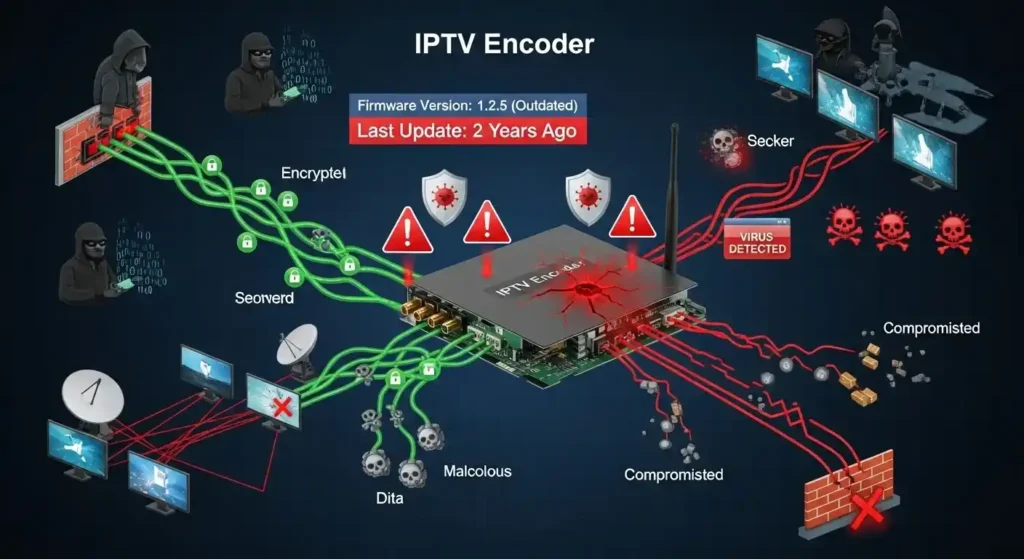
Real-World Consequences
A major sports broadcaster recently suffered a complete stream failure during a live championship game due to a known firmware bug that had been patched six months earlier. The incident cost them over $500,000 in advertising refunds and damaged viewer trust. IPTV encoder.
How to Fix: Systematic Update Management
Establish a proactive firmware maintenance strategy:
Update Schedule Framework
- Monthly: Check for critical security patches
- Quarterly: Review and plan major firmware updates
- Before major events: Verify current firmware stability
- After incidents: Immediate patch assessment and application
Safe Update Process
- Test Environment First: Never update production encoders without testing
- Backup Current Configuration: Save all settings before any firmware changes
- Schedule Maintenance Windows: Plan updates during low-traffic periods
- Rollback Preparation: Ensure you can quickly revert if issues arise
Security Monitoring Checklist
- Subscribe to manufacturer security bulletins
- Monitor CVE databases for encoder-specific vulnerabilities
- Implement network segmentation to isolate encoders
- Use VPN access for remote encoder management
- Enable detailed logging for security audit trails
Action Step: Create a firmware update calendar and designate a team member responsible for monitoring security announcements from your encoder manufacturer. IPTV encoder.
Mistake 3: Overcomplicating Your IPTV Encoder Setup with Unnecessary Features
Many streaming professionals fall into the trap of activating every available feature on their IPTV encoder, believing more options equal better performance. This approach actually increases instability, creates troubleshooting nightmares, and introduces potential failure points that can crash your entire streaming operation. IPTV encoder.
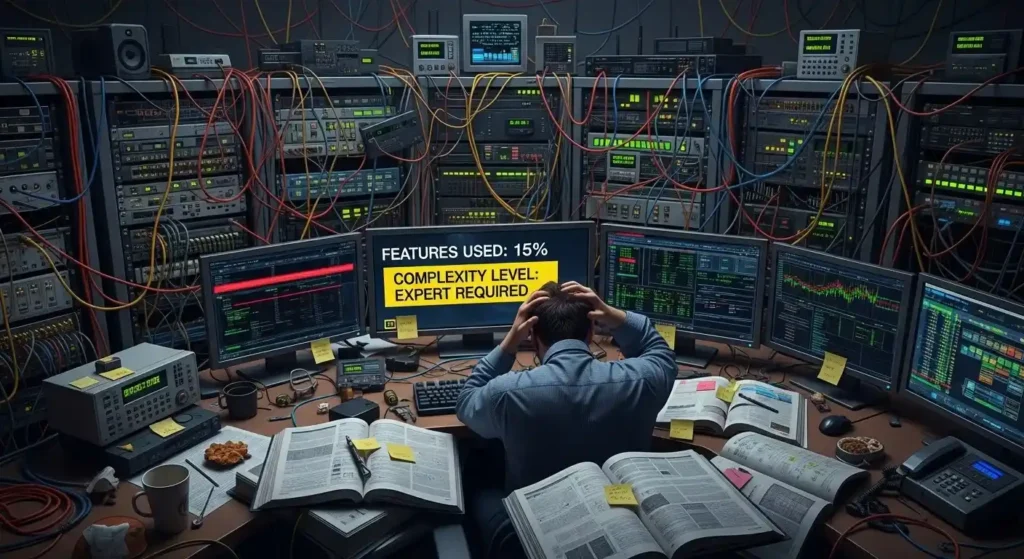
Why Complex Setups Fail
Advanced encoder features often conflict with each other or consume excessive processing resources. Common complications include: IPTV encoder.
- Multiple transcoding profiles competing for CPU resources
- Unnecessary preprocessing filters adding latency
- Complex audio routing creating sync issues
- Redundant monitoring systems generating false alerts
- Feature interactions causing unexpected behavior
Performance Impact Analysis
A simplified encoder configuration typically delivers:
- 15-20% better resource utilization
- Reduced latency by 200-500ms
- 40% fewer support tickets and troubleshooting calls
- Improved system reliability during peak loads
- Easier maintenance and configuration management
How to Fix: Streamlined Configuration Strategy
Follow the minimalist approach to encoder setup:
Essential Features Only
- Video Encoding: Use one primary profile optimized for your target audience
- Audio Processing: Minimal normalization and format conversion
- Network Output: Single protocol unless multiple formats are absolutely required
- Monitoring: Basic health metrics without excessive detail logging
Configuration Simplification Steps
- Audit Current Setup: Document every enabled feature and its purpose
- Identify Core Requirements: List only essential functionality for your use case
- Disable Unused Features: Turn off anything not directly supporting your streaming goals
- Test Performance Impact: Measure improvements in stability and resource usage
Stability-First Configuration Checklist
- Single video encoding profile for consistent performance
- Disable experimental or beta features in production
- Minimize real-time processing effects and filters
- Use hardware acceleration only for core encoding functions
- Eliminate redundant output streams and unnecessary protocols
Action Step: Conduct a “feature audit” of your current encoder setup and disable any functionality that doesn’t directly contribute to your streaming objectives. IPTV encoder.
Mistake 4: Ignoring Redundancy and Backup Options in Your IPTV Encoder Infrastructure
Single points of failure in streaming encoder setups cause catastrophic outages that can destroy live events and damage professional reputations. Without proper failover systems, a single hardware failure, power issue, or network problem can instantly terminate your broadcast with no recovery options. IPTV encoder.
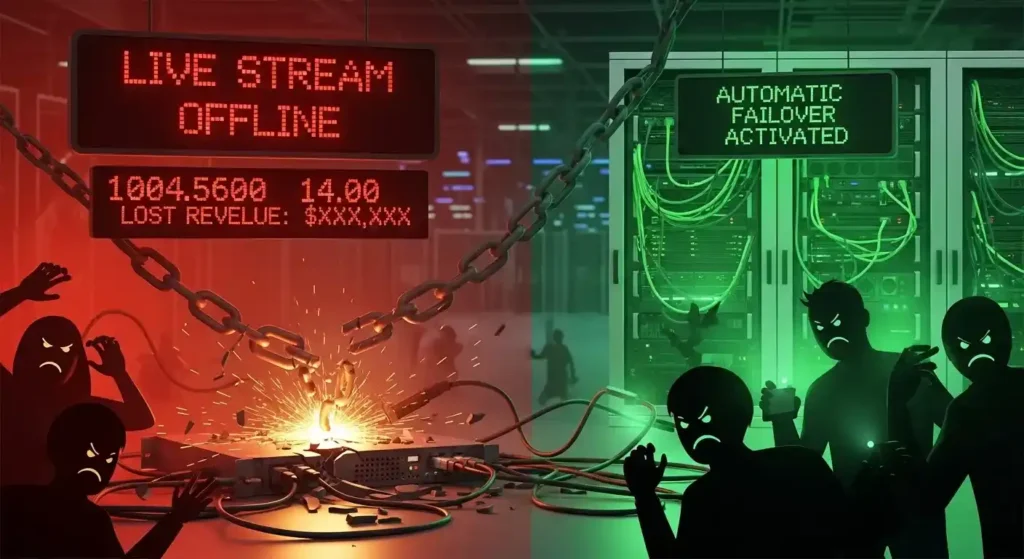
The Cost of Encoder Failures
Professional streaming operations report that single encoder failures cost an average of:
- $2,000-$5,000 per hour in lost advertising revenue
- 15-25% permanent viewer churn after major outages
- Potential contract penalties and legal issues for live events
- Irreparable damage to brand reputation and credibility
Common Single Points of Failure
Most encoder setups fail due to these overlooked vulnerabilities:
- Single encoder unit with no backup system
- Shared power supply serving both primary and “backup” systems
- Network connection without redundant internet providers
- Single input source with no failover content
- Centralized monitoring with no remote access capabilities
How to Fix: Multi-Layer Redundancy Architecture
Implement comprehensive failover protection:
Dual-Encoder Configuration
- Primary/Secondary Setup: Hot standby encoder ready for instant activation
- Load Balancing: Distribute encoding load across multiple units
- Geographic Distribution: Separate physical locations for disaster recovery
- Automatic Failover: Sub-30-second switching with no manual intervention
Infrastructure Redundancy Checklist
- Power: UPS systems with generator backup capability
- Network: Multiple ISPs with different infrastructure providers
- Input Sources: Backup content feeds and emergency programming
- Cooling: Redundant HVAC systems and temperature monitoring
- Monitoring: Remote access via cellular backup connections
Failover Testing Protocol
- Monthly Failover Drills: Practice switching to backup systems
- Load Testing: Verify backup encoders can handle full production load
- Recovery Time Measurement: Document and optimize switching speeds
- Alert System Verification: Confirm all monitoring notifications work properly
Action Step: Map all potential failure points in your current encoder setup and implement at least dual redundancy for any component whose failure would interrupt your stream.
Mistake 5: Underestimating Cooling and Environmental Requirements for IPTV Encoder Equipment
Professional streaming encoders generate substantial heat during intensive real-time encoding operations, yet many installations overlook proper environmental controls. Inadequate cooling leads to thermal throttling, reduced performance, and premature hardware failure that can cost thousands in replacement equipment and lost streaming revenue. IPTV encoder.
The Hidden Costs of Poor Cooling
Insufficient environmental control creates cascading problems:
- Performance Degradation: Encoders automatically reduce quality to prevent overheating
- Unexpected Shutdowns: Thermal protection circuits interrupt live streams
- Hardware Lifespan Reduction: Heat damage shortens equipment life by 50-70%
- Increased Maintenance Costs: More frequent repairs and component replacements
- Reliability Issues: Intermittent problems that are difficult to diagnose. IPTV encoder.
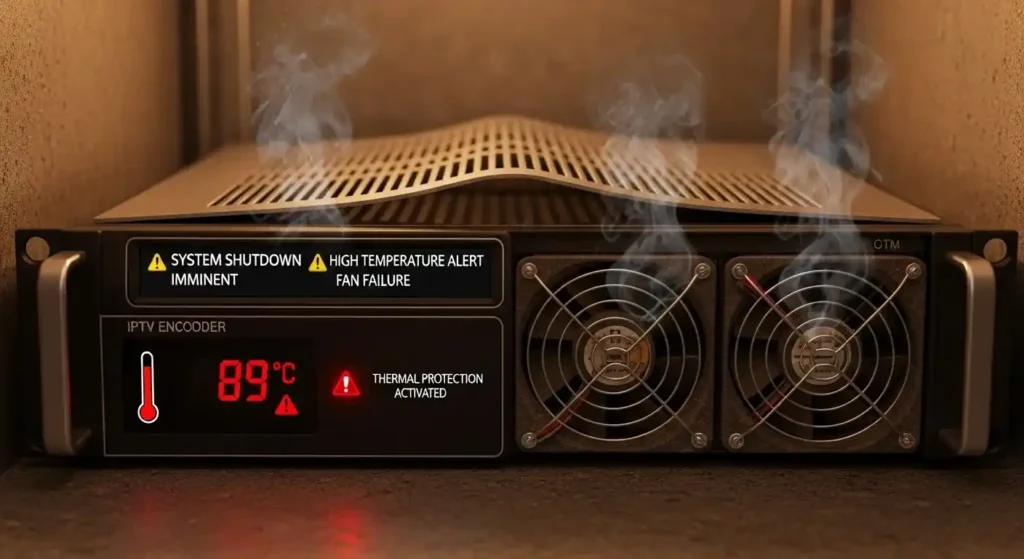
Real-World Temperature Impact
Professional encoder performance degrades predictably with temperature:
- 70-75°F: Optimal performance and maximum encoder capability
- 75-80°F: Minor performance reduction, acceptable for most applications
- 80-85°F: Noticeable encoding quality reduction and increased error rates
- 85-90°F: Significant throttling and potential stability issues
- Above 90°F: High risk of automatic shutdowns and hardware damage
How to Fix: Professional Environmental Management
Create optimal operating conditions for encoder stability:
Cooling System Requirements
- Dedicated HVAC: Separate climate control for encoder equipment areas
- Redundant Cooling: Backup systems to prevent single-point failures
- Airflow Design: Proper ventilation with hot/cold aisle separation
- Temperature Monitoring: 24/7 alerts for environmental conditions
Environmental Control Checklist
- Maintain ambient temperature between 68-75°F (20-24°C)
- Keep relative humidity between 45-55% to prevent condensation
- Provide adequate airflow (minimum 200 CFM per kW of heat generation)
- Install temperature and humidity sensors with remote monitoring
- Plan for heat load growth as you add encoding capacity
Monitoring and Alert Configuration
- Temperature Alerts: Set warnings at 76°F and critical alerts at 80°F
- Humidity Monitoring: Alert if levels exceed 60% or drop below 40%
- Equipment Health: Monitor encoder internal temperatures via SNMP
- Preventive Maintenance: Schedule regular HVAC system servicing
Action Step: Install temperature monitoring in your encoder room and document current operating conditions. If temperatures regularly exceed 75°F, implement immediate cooling improvements. IPTV encoder.
Mistake 6: Choosing an IPTV Encoder Without Long-Term Support Availability
Selecting encoder hardware without considering long-term manufacturer support and parts availability creates expensive problems down the road. When critical components fail or security vulnerabilities emerge, unsupported equipment leaves you with no recourse except costly complete system replacement. IPTV encoder.
The Support Lifecycle Problem
Many encoder manufacturers provide limited support windows:
- Consumer-Grade Equipment: Often discontinued after 2-3 years
- Professional Models: Typically supported for 3-5 years maximum
- Enterprise Systems: May offer 5-7 years but at premium pricing
- Specialized Hardware: Sometimes abandoned if manufacturer changes focus
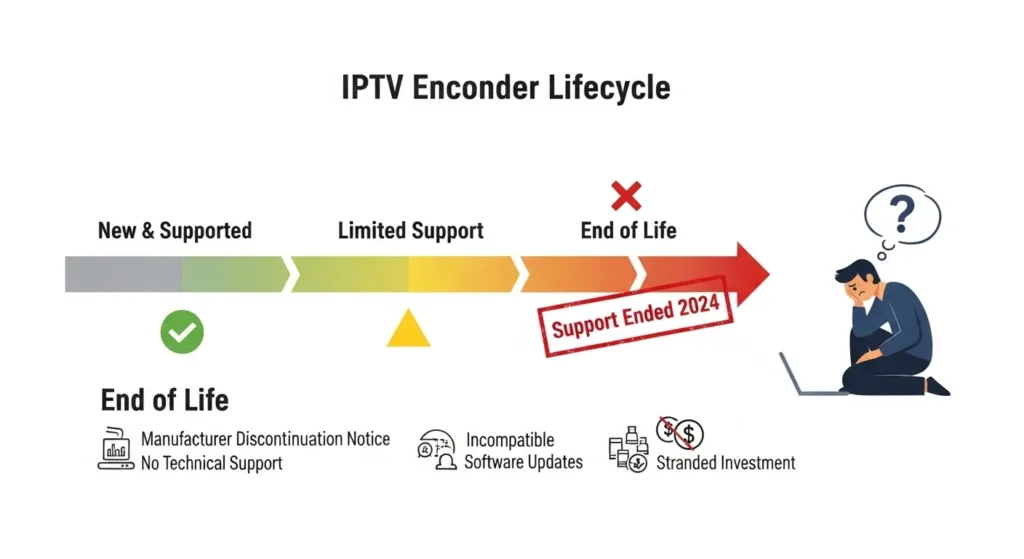
Long-Term Cost Impact
Inadequate support planning creates these expensive scenarios:
- Emergency replacement costs 3-5x normal pricing during critical events
- Complete system redesign when key components become unavailable
- Security vulnerabilities with no patches available
- Incompatibility with evolving streaming standards and protocols
- Loss of technical expertise as support staff move to newer products
How to Fix: Strategic Support Planning
Evaluate encoder support before making purchase decisions:
Manufacturer Assessment Criteria
- Company Stability: Financial health and market position
- Product Portfolio: Encoder development as core business focus
- Support History: Track record with previous product generations
- Update Frequency: Regular firmware releases and security patches
Due Diligence Checklist
- Verify minimum 5-year support commitment in writing
- Confirm parts availability timeline beyond warranty period
- Document technical support response times and escalation procedures
- Identify authorized repair facilities and replacement part sources
- Review manufacturer roadmap for future product evolution
Support Agreement Components
- Firmware Updates: Security patches and feature improvements
- Technical Support: Phone/email assistance with guaranteed response times
- Hardware Warranty: Replacement parts and repair services
- Documentation: Updated manuals and configuration guides
- Training: Ongoing education for new features and best practices
Action Step: Contact your encoder manufacturer to verify current support status and document the end-of-life timeline for your equipment. Plan replacement budgets accordingly. IPTV encoder.
Mistake 7: Failing to Plan for Future Scaling Needs in Your IPTV Encoder Setup
Many streaming operations design their encoder infrastructure for current requirements without considering growth scenarios. This short-sighted approach leads to expensive emergency upgrades, service interruptions during scaling, and architectural limitations that constrain business expansion.
The Scaling Challenge
Streaming businesses often experience rapid, unpredictable growth:
- Viral content can increase viewership 10-100x overnight
- New distribution partnerships require additional encoder capacity
- Quality standards evolve, demanding higher bitrates and resolutions
- Geographic expansion needs multiple encoding locations
- Regulatory changes may require content redundancy and archiving
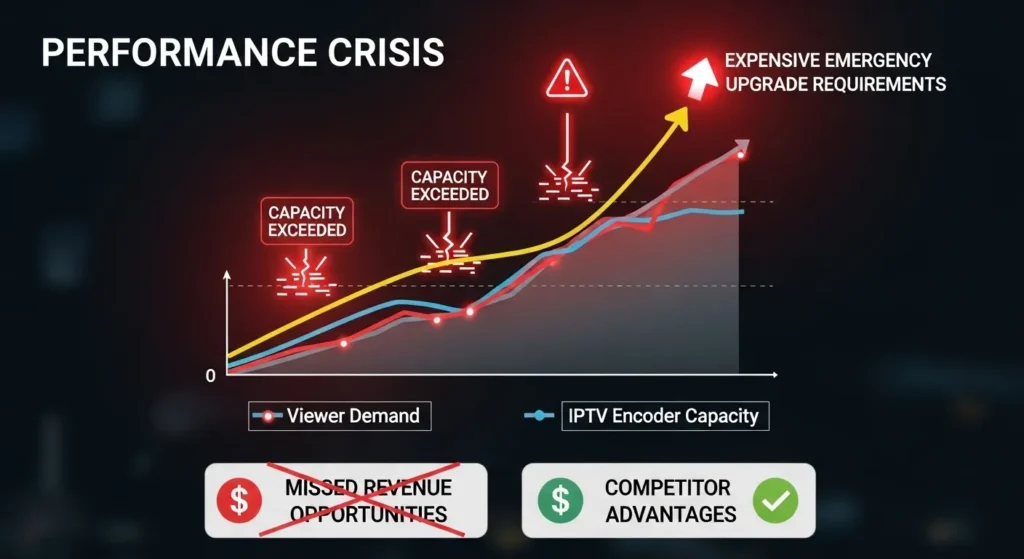
Common Scaling Mistakes
Organizations frequently encounter these expansion obstacles:
- Insufficient Processing Headroom: Encoders already operating at capacity
- Network Bandwidth Limitations: Unable to handle additional streams
- Cooling and Power Constraints: Physical infrastructure cannot support growth
- Configuration Complexity: Adding capacity requires complete system redesign
- Budget Surprises: Scaling costs far exceed original projections
How to Fix: Growth-Ready Architecture Planning
Design encoder infrastructure with expansion capability:
Capacity Planning Framework
- Current Load Analysis: Document existing encoder utilization rates
- Growth Projections: Plan for 3-5x current capacity within 24 months
- Peak Traffic Planning: Design for seasonal spikes and viral content scenarios
- Quality Upgrade Path: Consider 4K and next-generation codec requirements
Scalable Infrastructure Design
- Modular Architecture: Add encoding capacity without service disruption
- Load Balancing: Distribute processing across multiple encoder units
- Cloud Hybrid Options: Supplement on-premise equipment with cloud encoding
- Automation Tools: Streamline configuration management for multiple encoders
Growth Planning Checklist
- Calculate current encoder utilization (aim for maximum 60-70% capacity)
- Plan power and cooling infrastructure for 2x current equipment
- Design network architecture supporting 5x current bandwidth requirements
- Budget for annual capacity additions based on growth projections
- Establish vendor relationships for rapid equipment procurement
Future-Proofing Strategies
- Standards Compliance: Ensure compatibility with emerging streaming protocols
- Codec Evolution: Plan for AV1, VVC, and next-generation encoding standards
- API Integration: Select encoders supporting automated management systems
- Monitoring Scalability: Implement centralized monitoring supporting hundreds of streams
Action Step: Calculate your current encoder capacity utilization and create a 3-year scaling plan with specific equipment and budget requirements for each growth milestone. IPTV encoder.
Final Checklist to Avoid IPTV Encoder Mistakes
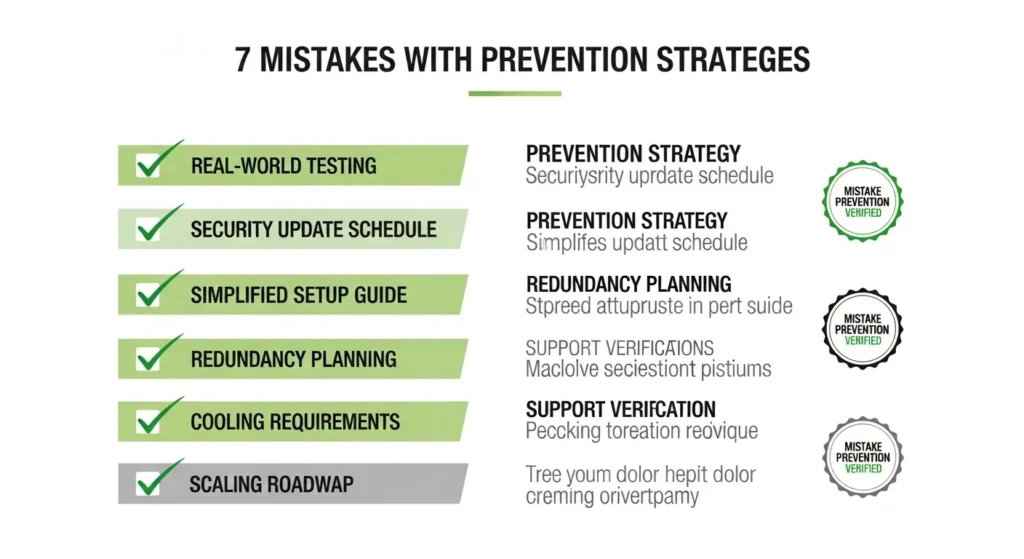
Use this comprehensive checklist to audit your current encoder setup and prevent costly streaming failures:
Pre-Deployment Testing
- [ ] Complete 72-hour stress testing under realistic network conditions
- [ ] Verify encoder performance with all planned input sources
- [ ] Test failover procedures and backup system activation
- [ ] Document baseline performance metrics for ongoing monitoring
Security and Maintenance
- [ ] Implement systematic firmware update schedule
- [ ] Enable security monitoring and intrusion detection
- [ ] Configure automated backup of encoder configurations
- [ ] Establish vendor support agreements with response time guarantees
Infrastructure Reliability
- [ ] Install redundant power systems with UPS protection
- [ ] Implement dual internet connections from different providers
- [ ] Deploy backup encoder systems with automatic failover
- [ ] Monitor environmental conditions with remote alerting
Performance Optimization
- [ ] Simplify encoder configuration to essential features only
- [ ] Optimize cooling systems for sustained high-performance operation
- [ ] Plan encoder capacity for 3x current usage requirements
- [ ] Document troubleshooting procedures for common issues
Long-Term Planning
- [ ] Verify manufacturer support timeline extends beyond your planning horizon
- [ ] Create scaling roadmap with specific capacity milestones
- [ ] Budget for regular equipment refresh cycles
- [ ] Establish vendor relationships for rapid emergency procurement
Conclusion: Safeguarding Your Streaming Investment
Professional streaming success depends on avoiding these seven critical IPTV encoder mistakes that destroy countless broadcasts every year. By implementing comprehensive testing, maintaining proper environmental controls, planning for redundancy, and designing for growth, you create a streaming infrastructure that supports your business objectives reliably. IPTV encoder.
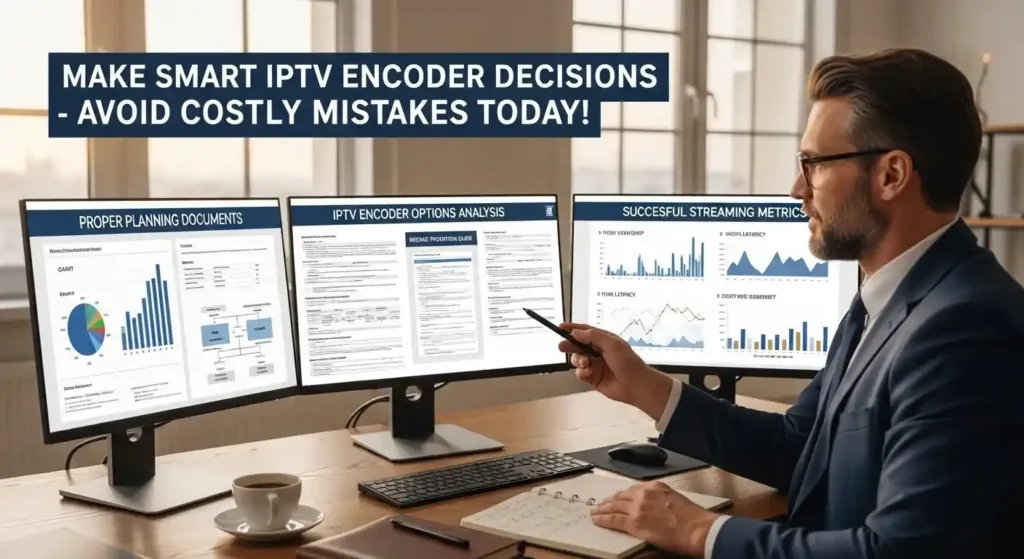
The streaming industry’s rapid evolution means that encoder management practices from even two years ago are now obsolete. Viewers expect flawless performance across all devices and network conditions, making proper encoder configuration and maintenance more critical than ever.
Remember that encoder problems often cascade—a simple cooling issue can cause performance throttling that leads to quality complaints, increased support costs, and ultimately viewer churn. Investing in proper encoder infrastructure and operational procedures pays dividends through improved reliability, reduced maintenance costs, and protected revenue streams.
Take action now to audit your current encoder setup using this guide’s recommendations. The cost of prevention is always lower than the price of streaming failures, especially when they occur during critical broadcast moments that define your professional reputation.
Your streaming success starts with bulletproof encoder infrastructure—make sure these seven mistakes never threaten your operations.

